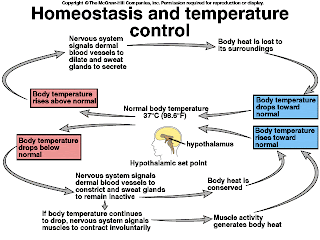Wednesday, September 29, 2010
Homeostasis
Have you ever wondered how your body stays maintained and keeps going after a long hard work out? Thanks to homeostasis it keeps the body sustained and manages to keep it to how it was origanilly before you started your excersize. Homeostasis is the ability to maintain a relatively stable internal environment in an ever-changing outside world. As sooon as your body starts to change there are these three interdependent components of control mechanisms. The receptor monitors the environments and responds to change. The control center determines the set point at which the variable is maintained. The effector provides the means to respond to the estimulus. There are negative and positive feedback in homeostasis. In negative feed back, the output shuts off the stimulus. For an example the regulation of blood glucose levels. In a positive feedback system, the output inhances or exaggerates the original stimulus. An example of this would be regulation of blood clotting. Overwhelming of the negative feedback mechanisms may allow destructive positive feedback mechanisms to take over.
Thursday, September 16, 2010
Homeostasis Lab
For our homeostasis experiment we followed a number of steps. We measured Jill's elbows temperature while she was resting in class and it comfortably leveled out around 87 degrees. Then we measured her elbows temperature after she had been lifting weights for over 20 minutes. Her temperature continued to climb until it leveled out around 98 degrees. After sitting and cooling off for quite some time Jill's temperature finally lowered back down to 87 degrees. This is an example of negative feedback because her body was able to cool back down after getting so hot. In the end Jill's temperature finally reached homeostasis.




Subscribe to:
Posts (Atom)









